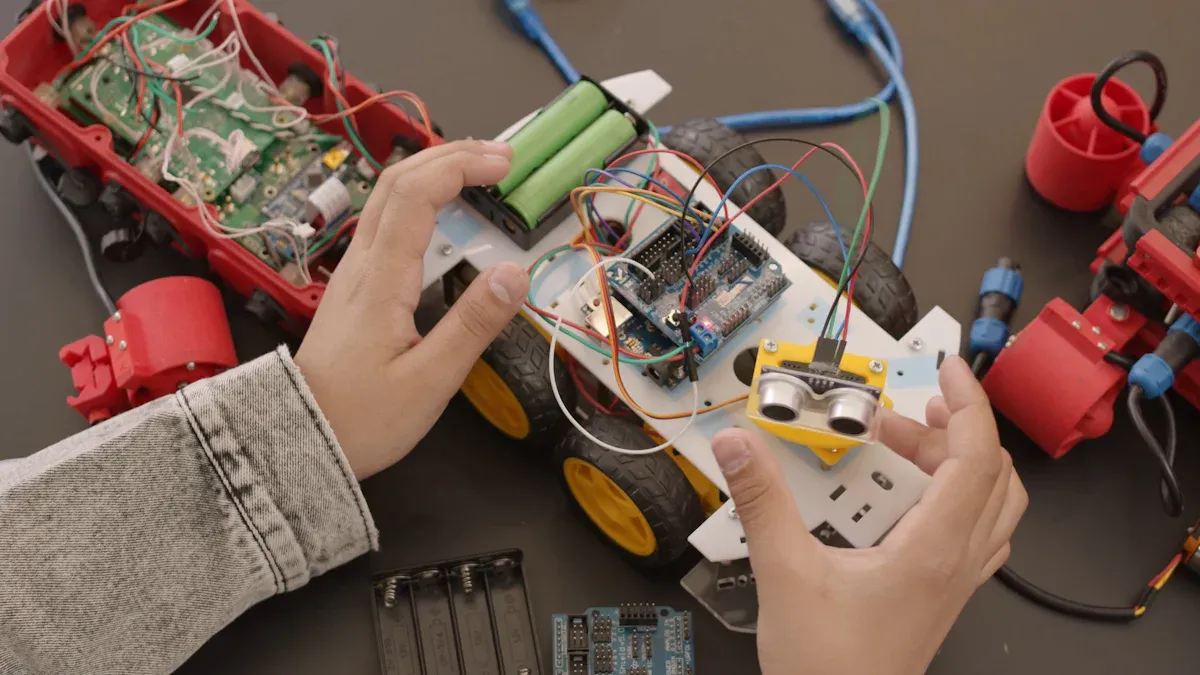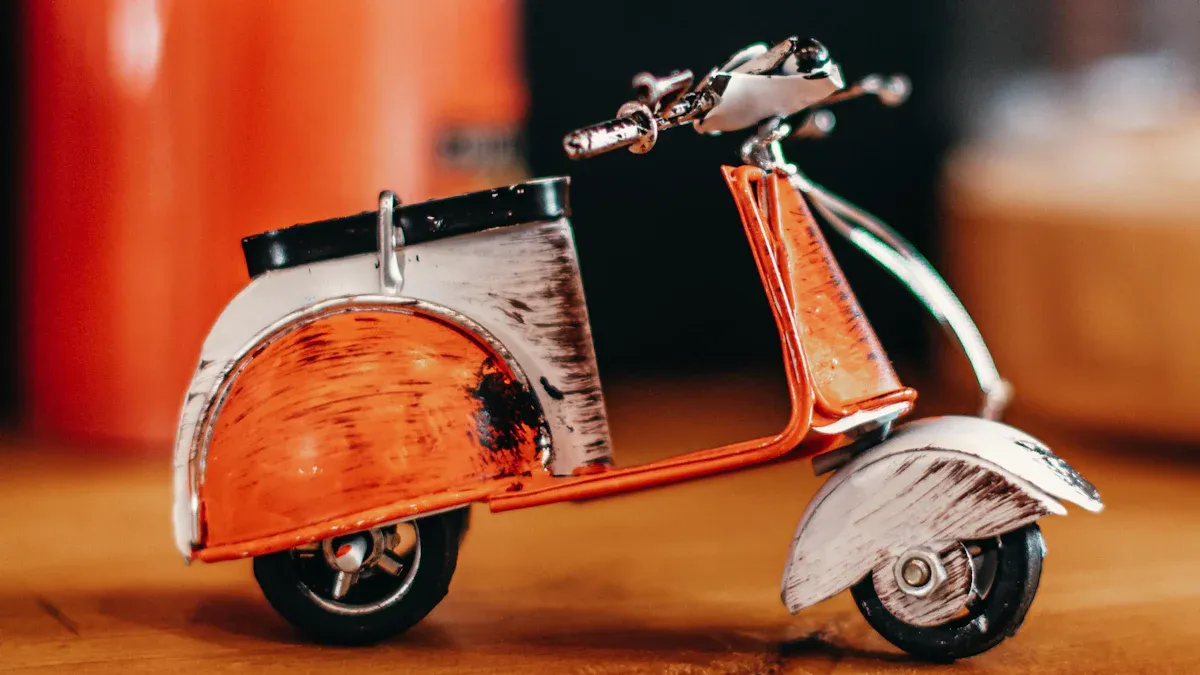3 easy small hobby motor ideas for beginners

Looking for a fun way to get started with DIY projects? Try making a small hobby motor fan, a DIY motor car, or a vibrating art bot! You only need simple materials, and you don’t need any special skills. Small hobby motors are easy to find and budget-friendly—Mabuchi Motor Corporation alone makes over 1.5 billion each year, and you can buy them for less than the price of candy.
Big brands like Tamiya and Traxxas offer strong support and plenty of spare parts.
The growing DIY trend means even more options and helpful online communities.
Key Takeaways
Small hobby motors do not cost much and are simple to use. They are great for beginners who want to try fun DIY projects.
You can make a motor fan, a motor car, or a vibrating art bot. These projects help you see how motors work. You also get to build cool things that move.
Use easy-to-find things like batteries, bottle caps, and cardboard. You do not need special skills or tools to make your projects.
Always check your wires and use new batteries. This helps your motor work well and stay safe.
Try out different shapes and decorations for your projects. This makes your work special and helps you learn more about motors and how they move.
1. Small Hobby Motor Fan
Building a small hobby motor fan is a great way to see how motors work. You can use a 130-size small hobby motor to spin a homemade fan blade. This project is quick, safe, and perfect for beginners. You’ll get to see your fan spin in just a few minutes!
Materials
130-size small hobby motor (1.5V–3V)
AA battery (or 9V battery with clip)
Battery holder
Electrical tape or alligator clips (for solderless connections)
Plastic bottle cap or stiff paper (for fan blades)
Scissors
Glue or double-sided tape
Steps
Cut out two or three fan blades from a plastic bottle cap or stiff paper. Make sure they are the same size.
Glue or tape the blades evenly around the motor’s shaft. Let the glue dry.
Attach the battery holder wires to the motor terminals. Use alligator clips or electrical tape for easy, solderless connections.
Insert the battery into the holder.
Hold the motor by its body and flip the switch (or connect the wires). Watch your fan spin!
Tip: If the fan doesn’t spin, try flipping the battery wires. Sometimes the motor needs a little push to get started.
Tips
Always keep your fingers away from the spinning blades.
Use a fresh battery for the best results. A small hobby motor works best with 1.5V–3V.
If the fan doesn’t start, check the connections and make sure the blades aren’t stuck.
Try different blade shapes to see which one spins fastest.
Here’s a quick troubleshooting guide if you run into problems:
Problem | Cause | Solution |
|---|---|---|
Fan doesn’t spin | Dead spot or bad connection | Give the blades a push; check wire contacts |
Motor gets hot | Too much voltage | Use only 1.5V–3V battery |
Blades don’t move smoothly | Obstruction or misalignment | Adjust blades; add a tiny drop of oil |
Motor stops after a while | Battery low or dead | Replace battery |
Experiment with different fan designs and see what works best. You’ll learn a lot about how a small hobby motor works!
2. DIY Motor Car
Building your own motor car is a classic project that never gets old. You get to see how a small hobby motor can turn simple materials into a moving vehicle. This project uses things you probably already have at home, like cardboard and bottle caps. You’ll also learn a bit about wiring and how gears can change speed or torque.
Materials
1 small hobby motor (1.5V–3V)
1 AA or 9V battery with holder
4 bottle caps (for wheels)
2 wooden skewers or straws (for axles)
1 small cardboard box (for the car body)
Electrical tape or alligator clips
Scissors
Hot glue or strong tape
Small gear or propeller (optional, for more speed)
Switch (optional, for easy on/off)
Steps
Cut two straws to fit across the bottom of your cardboard box. These will hold the axles.
Glue the straws to the bottom of the box.
Cut the skewers a bit longer than the straws. Slide one skewer through each straw.
Push a bottle cap onto each end of the skewers to make wheels. Use glue if they feel loose.
Attach the small hobby motor to the top or side of the box. Make sure the shaft sticks out.
If you have a gear or propeller, push it onto the motor shaft.
Connect the battery holder wires to the motor using alligator clips or tape. Add a switch if you want.
Secure the battery holder to the car body.
Flip the switch or connect the wires. Watch your car roll!
Tip: If your car doesn’t move, check that the wheels spin freely and the motor shaft touches the ground or a gear.
Tips
Try using different gears or propellers. Gears can make your car go faster or give it more power to climb.
Use a fresh battery for the best results.
Make sure the wheels are straight. Wobbly wheels can slow your car down.
If you want to experiment, try changing the size of the car body or the wheels.
Here are some things to know about small hobby motors in cars:
Power and efficiency drop as the motor gets smaller.
Most energy loss comes from incomplete combustion, heat, and friction.
Power output drops less quickly than efficiency, so you still get good movement.
Improving how the motor uses energy can make your car go farther.
You can always tweak your design. Try different materials or shapes. Each change teaches you something new about how cars and motors work!
3. Vibrating Art Bot

Ever wanted to make a robot that draws on its own? You can build a vibrating art bot using a small hobby motor and a few craft supplies. This little robot wiggles around and creates wild, colorful patterns. It’s a fun way to see how motors can move things in creative ways.
Materials
1 small hobby motor (1.5V–3V)
AA battery with holder (or a coin cell battery)
Electrical tape or alligator clips
Plastic cup or empty yogurt container (for the body)
3 or 4 markers (for legs)
Small piece of modeling clay or a hot glue stick (for the off-center weight)
Paper (for drawing surface)
Googly eyes or stickers (optional, for decoration)
Steps
Tape or glue the markers evenly around the rim of the cup. These will be the legs and drawing tools.
Attach the small hobby motor to the top of the cup. Make sure the shaft sticks out.
Press a small piece of modeling clay or a bit of hot glue onto the motor shaft. Place it off to one side, not in the center. This makes the motor vibrate.
Connect the battery holder wires to the motor terminals. Use alligator clips or electrical tape for a solderless setup.
Place your art bot on a big sheet of paper.
Turn on the motor. Watch your bot wiggle and draw!
Tip: If your art bot doesn’t move much, try adding more weight to the motor shaft or adjusting the marker legs.
Tips
Use a fresh battery for stronger vibrations.
Try different marker lengths or cup sizes to change how your bot moves.
Decorate your art bot with stickers or googly eyes for extra fun.
If your bot spins in circles or gets stuck, move the weight or markers until it moves better.
Invite friends to build their own bots and have a drawing contest!
Here’s a quick troubleshooting table:
Problem | Cause | Solution |
|---|---|---|
Bot won’t move | Not enough vibration | Add more weight to shaft |
Bot falls over | Markers not even | Adjust marker positions |
No drawing marks | Markers not touching paper | Push markers down further |
You can get creative with your art bot. Try different shapes, colors, or even add a second motor for wild moves. This project helps you see how a small hobby motor can turn simple parts into a moving, drawing robot.
You just learned how to make a fan, a motor car, and a vibrating art bot. These projects help you see how motors work and let you get creative.
Try building one today.
Share your results with friends or family.
Want to learn more? Join an online hobby group or look up new motor projects.
Every project you try helps you learn something new!
FAQ
How safe are these small hobby motor projects?
You can build these projects safely if you follow a few rules. Keep fingers away from spinning parts. Always use low-voltage batteries. Ask an adult for help with sharp tools or hot glue. Safety first!
Where can I buy small hobby motors?
You can find small hobby motors at craft stores, online shops like Amazon, or even in old toys. Look for “130-size hobby motor” or “DC motor” in the product name.
What should I do if my motor doesn’t work?
Try these steps:
Make sure wires touch the metal parts.
Give the motor shaft a gentle spin.
Try switching the battery wires.
Can I use any battery for these projects?
Stick with AA or 9V batteries. These work best with small hobby motors. Avoid using big batteries or wall outlets. Too much power can break your motor.
How can I make my project look cooler?
Decorate your project with stickers, paint, or googly eyes. Try using colored paper or fun shapes for the body. Let your creativity shine!
See Also
How To Choose The Ideal Compact Vibrator Motor
Effective Techniques For Reducing Noise And Vibration In Motors
Innovative Ideas For Using Small Motors In Smart Homes
Cutting Edge Uses For Mini Motor Parts In Electronics
Simple Guide To Mastering Arduino Controlled Vibration Motors
Get Custom Micro DC Motors from
INEED Motors!
Leading Brand in Vibration Motor Manufacturing Industry
